COMM203 - Chapter 10 (Answers)-2 PDF

| Title | COMM203 - Chapter 10 (Answers)-2 |
|---|---|
| Author | yousuf vyani |
| Course | Introduction to Finance |
| Institution | University of Saskatchewan |
| Pages | 5 |
| File Size | 171.9 KB |
| File Type | |
| Total Downloads | 11 |
| Total Views | 144 |
Summary
Download COMM203 - Chapter 10 (Answers)-2 PDF
Description
1 COMM203: Chapter 10 - NPV and Other Investment Criteria (5 Questions) Q1) White Oak Garden Inc. is looking at setting up a new manufacturing plant in London, Ontario to produce garden tools. The company bought some land six years ago for $6,000,000 in anticipation of using it as a warehouse and distribution site, but the company has since decided to rent these facilities from a competitor instead. If the land were sold today, the company would net $6,400,000. The company wants to build its new manufacturing plant on this land; the plant will cost $14,200,000 to build, and the site requires $890,000 worth of grading before it is suitable for construction. What is the proper cash-flow amount to use as the initial investment in fixed assets when evaluating this project? Why? Answer: The $6,000,000 acquisition cost of the land six years ago is a sunk cost. The $6,400,000 current after tax value of the land is an opportunity cost if the land is used rather than sold off. The $14,200,000 cash outlay and $890,000 grading expenses are the initial fixed asset investments needed to get the project going. Proper year zero cash flow to use in evaluating this project = $6,400,000 + 14,200,000 + 890,000 = $21,490,000
Q5) A proposed new project has projected sales of $108,000, costs of $51,000, and CCA of $6,800. The tax rate is 35%. Calculate operating cash flow using the four different approaches described in the chapter and verify that the answer is the same in each case. Answer: To calculate the operating cash flow (OCF), we first need to calculate net income. The income statement is: Sales Variable costs
Income Statement $108,000 51,000
Depreciation EBT Taxes@35%
6,800 $50,200 17,570
Net income
$32,630
Using the most common financial calculation for operating cash flow (OCF), we get: OCF = EBIT + Depreciation – Taxes = $50,200 + 6,800 – 17,570 = $39,430 The top-down approach to calculating OCF yields: OCF = Sales – Costs – Taxes = $108,000 – 51,000 – 17,570 = $39,430
The tax-shield approach is: OCF = (Sales – Costs)(1 – TC) + TC x Depreciation = ($108,000 – 51,000)(1 – .35) + .35(6,800) = $39,430 TC = Corporate tax rate And the bottom-up approach is: OCF = Net income + Depreciation = $32,630 + 6,800 = $39,430
All four methods of calculating OCF should always give the same answer.
2 Q7) A new electronic process monitor costs $990,000. This cost could be depreciated at 30% per year (Class 10). The monitor would actually be worthless in five years. The new monitor would save $460,000 per year before taxes and operating costs. If we require a 15% return, what is the NPV of the purchase? Assume a tax rate of 40%. Answer: Cash flow year 0 = -990,000 Cash flow years 1 through 5 = CF before tax x (1 – Tc) = 460,000(1 – .40) = $276,000
1− PVIFA=
1 ( 1+r )t r
PV tax shield on CCA =
IdT c 1+0 . 5 r S n dT c 1 × × − d +r (1+r )n d+ r 1+r
I = Total Capital Investment; d = CCA tax rate; Tc = Corporate Tax Rate; r = discount rate; Sn = Salvage value in year n; n = number of periods in the project PV of CCATS = 990,000(.3)(.4) x (1 + .5(.15)) = .15 + .30 1 + .15 = (118,800 / .45) x 0.93478 = 264,000 x 0.93478 = 246,782 Present value of annuity (PVA) = C({1 - [1/(1 + r)]t } / r) -Initial costs + PV of CF + PVCCATS NPV: -990000 + 276,000 x PVIFA (15%, 5) + 246,782.61 PVIFA = Present value interest factor of an annuity; PVIF = Present value interest factor; = -990,000 + 276,000 x {1 – [1/1+.15]5/.15} + 246,782 = -990,000 + (276,000 x 3.35216) + 246,782 = -990,000 + 925,196 + 246,782 = $181,978
3
Following questions to be answered in the classroom Q8) Previous problem (Q7): A new electronic process monitor costs $990,000. This cost could be depreciated at 30% per year (Class 10). The monitor would actually be worthless in five years. The new monitor would save $460,000 per year before taxes and operating costs. If we require a 15% return, what is the NPV of the purchase? Assume a tax rate of 40%. Additional information: In the previous question (Q7), suppose the new monitor also requires us to increase net working capital by $47,200 when we buy it. Further suppose that the monitor could actually be worth $100,000 in five years. What is the new NPV?
Answer: Cash flow year 0 = -990,000 - 47,200 = -$1,037,200 Cash flow years 1 through 5 = CF before tax x (1 – Tc) = 460,000(1 - .4) = $276,000 Ending cash flow = Salvage value + NWC = 100,000 + 47,200 = $147,200
1−
1 t
PVIFA=
( 1+r ) r
PV tax shield on CCA =
IdT c 1+0 . 5 r S n dT c 1 × − × d+ r 1+r d +r (1+r )n
I = Total Capital Investment; d = CCA tax rate; Tc = Corporate Tax Rate; r = discount rate; Sn = Salvage value in year n; n = number of periods in the project PV of CCATS = 990,000 x .30 x .40 x (1 + .5(.15)) - 100,000 x .30 x .40 x 1__ .15 + .30 1 + .15 .15 + .30 (1.15) 5 = [(118,800 / .45) x 0.93478] – [(12,000 / .45) x 0.49718] = (264,000 x 0.93478) – 26,667 x 0.49718 = 246,782 – 13,258 = $233,524 PV of annuity (PVA) = C({1 - [1/(1 + r)]t } / r); PV factor = 1 / (1 + r)t; NPV = -Initial costs + PV of CF + PVCCATS
NPV = -1,037,200+ 276,000 x PVIFA(15%, 5) + 147,200 /(1.15)5 + 233,524.56 = $194,703.78 = -1,037,200 + 276,000 x {1 – [1/1+.15]5/.15} + 147,200 / (1.15)5 + 233,524 = -1,037,200 + (276,000 x 3.35216) + (147,200 x 0.49718) + 233,524 = -1,037,200 + 925,196 + 73,185 + 233,524 = 194,705
4 Q27)Lobo is a leading manufacturer of positronic brains, a key component in robots. The company is considering two alternative production methods. The costs and lives associated with each are: Year 0 1 2 3 4
Method 1 Method 2 -$6,700 -$9,900 400 620 400 620 400 620 620
Assuming that Lobo will not replace the equipment when it wears out, which should it buy? If Lobo is going to replace the equipment, which should it buy (r = 13%)? Ignore depreciation and taxes in answering.
Answer: PV of annuity (PVA)= C({1 - [1/(1 + r)]t } / r); PV factor = 1 / (1 + r)t; NPV = -Initial costs + PV of CF + PVCCATS Method 1: PV@13%(Costs) = -$6,700 – 400 PVIFA (13%, 3) = -6,700 – 400 x 2.36115 = -6,700 – 944.46 = -$7,644.46 Method 2: PV@13%(Costs) = -$9,900 - 620 PVIFA (13%, 4) = -9,900 - 620 x 2.97447 = -9,900 - 1,844.17 = -$11,744.17 Difference = 11,744.17 - 7,644.46 = $4,099.71 in favor of Method 1 (Method 2 costs more to operate) PVIFA = Present value interest factor of an annuity; PV = Present value
Without replacement: On this basis we would need to know whether the benefit of 1 more year’s use is sufficient to offset the additional cost of $4,099.71.
1− PVIFA=
1 ( 1+r )t r
With replacement: Method 1: Equivalent annual cost (EAC) = -7,644.46 / PVIFA(13%,3) = -7,644.46 / 2.36115 = -$3,237.60
Method 2: Equivalent annual cost (EAC) = -11,744.17 / PVIFA(13%,4) = -11,744.17 / 2.97447 = -$3,948.32 On this basis, Method 2 is again more expensive. (Difference: 3,948.32 – 3,237.60 = 710.72)
Q29) – Optional not required A five-year project has an initial fixed asset investment of $270,000, an initial NWC investment of $25,000, and an annual OCF of −$42,000. The assets belong in a 20% CCA class and will have no salvage value. If the required return is 11% and tax rate is 34%, what is this project's equivalent annual cost, or EAC?
Answer: To calculate the EAC of the project, we first need the NPV of the project. Notice that we include the NWC expenditure at the beginning of the project and recover the NWC at the end of the project. The NPV of the project is:
1− PVIFA=
1 ( 1+r )t r
PV tax shield on CCA =
IdT c 1+0 . 5 r S n dT c 1 × − × d+ r 1+r d +r (1+r )n
PVCCATS = (270,000 x .20 x .34) / (.20 + .11) x (1.055 / 1.11) – (0 x .20 x .34) x (1/1.11) 5 = (59,226 x 0.95045) + 0 = 56,291
NPV of cost savings = –$270,000 – 25,000 – $42,000(PVIFA 11%,5) + $25,000 / (1.11)5 = -270,000 – 25,000 – (42,000 x 3.6959) + (25,000 x 0.59345) + 56,291 = -295,000 – 155,228 + 14,836 + 56,291 = -$379,101 Now we can find the EAC of the project. EAC = NPV / PVA = –$379,101 / (PVIFA 11%,5) = -379,101 / 3.6959 = –$102,573
5 Present value of annuity (PVA) = NPV x ({1 - [1/(1 + r)]t } / r)
COMM203: Chapter 10 - Classroom Quizzes (Answers) Consider the following two projects: Project A B
Year 0 Year 1 Year 2 Year 3 Year 4 Discount Cash Flow Cash Flow Cash Flow Cash Flow Cash Flow Rate -100 40 50 60 N/A .15 -73 30 30 30 30 .15
1) Assume that projects A and B are mutually exclusive. What is the correct investment decision and the best rationale for that decision? A) Invest in project A since NPVB < NPVA B) Invest in project B since IRRB > IRRA C) Invest in project B since NPVB > NPVA D) Invest in project A since NPVA > 0 Answer: (C) NPVA = -100 + 40 / (1.15)1 + 50 / (1.15)2 + 60 / (1.15)3 = 12.04 NPVB = -73+ 30 / (1.15)1 + 30 / (1.15)2 + 30 / (1.15)3 + 30 / (1.15)4 = 12.64 2) You are opening up a brand new retail strip mall. You presently have more potential retail outlets wanting to locate in your mall than you have space available. What is the most appropriate tool to use if you are trying to determine the optimal allocation of your retail space? A) IRR B) Payback period C) NPV D) Profitability index E) None of these Answer: (D) 3) If firm's objective is to maximize wealth, A) the rule of the Profitability Index will always give you the correct answer. B) the rule of the Net Present Value will always give you the correct answer. C) the rule of the Payback Period will always give you the correct answer. D) the rule of the Internal Rate of Return will always give you the correct answer. Answer: (B) Use the information for the question(s) below. The Sisyphean Company is planning on investing in a new project. This will involve the purchase of some new machinery costing $450,000. The Sisyphean Company expects cash inflows from this project as detailed below: Year One $200,000
Year Two $225,000
Year Three $275,000
Year Four $200,000
The appropriate discount rate for this project is 16%. 4) The profitability index for this project is closest to: A) .44 B) .26 C) 0.39 D) .34 E) None of these Answer: (C) PI = NPV / Investment; NPV = -450000 + 200000/(1.16)1 + 225000/(1.16)2 + 275000/(1.16)3 + 2000000/(1.16)4 = 176,265; So, PI = 176265 / 450000 = 0.39 5) Judson Industries is considering a new project. The project will initially require $749,000 for new fixed assets, $238,000 for additional inventory, and $25,000 for additional accounts receivable. Accounts payable is expected to increase by $70,001. The fixed assets will belong in a 30% CCA class. At the end of the project, in four years' time, the fixed assets can be sold for 40% of their original cost. The net working capital will return to its original level at the end of the project. The project is expected to generate annual sales of $944,000 with related cash expenses of $620,001. The tax rate is 35% and the required rate of return is 14%. What is the amount of the present value of the CCA tax shield for this project? A. $104,860 B. $112,290 C. $125,432 D. $144,920 E. $199,600 Answer: (C) Salvage value = 749,000 x .40 = $299,600 PVCCATS = [(749,000 x .30 x .35) / (.30 + .14)] x [(1 + .50 x .14) / 1.14] – [(299,600 x .30 x .35) / .30 + .14] x 1/(1.14)4 = (178,739 x 0.93860) – 71,495 x .59208 = 167,764 – 42,331 = 125,433
PV tax shield on CCA =
IdT c 1+0 . 5 r S n dT c 1 × × − d +r (1+r )n d+r 1+r
6) Which of the following is the best definition for sunk cost? A. Depreciation method under Canadian tax law allowing for the accelerated write-off of property under various classifications. B. A cost that has already been incurred and cannot be removed and therefore should not be considered in an investment decision. C. Evaluation of a project based on the project's incremental cash flows. D. Financial statements projecting future years' operations. E. The most valuable alternative that is given up if a particular investment is undertaken. Answer: (B)...
Similar Free PDFs

COMM203 - Chapter 10 (Answers)-2
- 5 Pages

Chapter 10 quiz #10
- 3 Pages

Notes 10 - Chapter 10
- 5 Pages
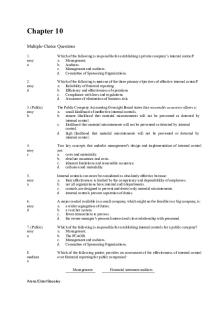
Chapter-10
- 19 Pages
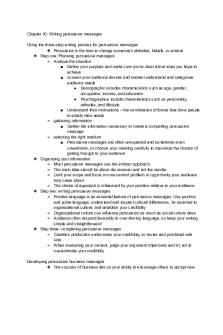
Chapter 10
- 5 Pages
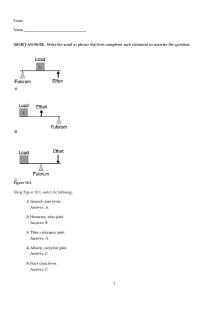
Chapter 10
- 14 Pages

Chapter 10
- 111 Pages
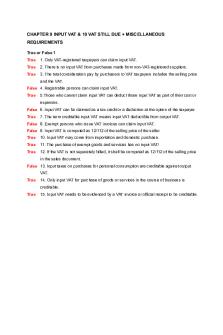
Chapter 10
- 16 Pages
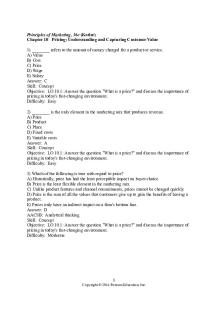
Chapter 10
- 47 Pages
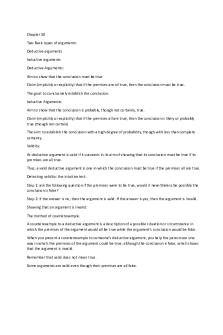
Chapter 10
- 4 Pages
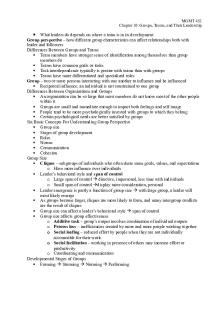
Chapter 10
- 5 Pages
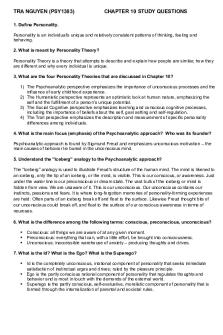
Chapter 10
- 6 Pages

Chapter 10
- 13 Pages

Chapter 10
- 10 Pages

Chapter 10
- 3 Pages
Popular Institutions
- Tinajero National High School - Annex
- Politeknik Caltex Riau
- Yokohama City University
- SGT University
- University of Al-Qadisiyah
- Divine Word College of Vigan
- Techniek College Rotterdam
- Universidade de Santiago
- Universiti Teknologi MARA Cawangan Johor Kampus Pasir Gudang
- Poltekkes Kemenkes Yogyakarta
- Baguio City National High School
- Colegio san marcos
- preparatoria uno
- Centro de Bachillerato Tecnológico Industrial y de Servicios No. 107
- Dalian Maritime University
- Quang Trung Secondary School
- Colegio Tecnológico en Informática
- Corporación Regional de Educación Superior
- Grupo CEDVA
- Dar Al Uloom University
- Centro de Estudios Preuniversitarios de la Universidad Nacional de Ingeniería
- 上智大学
- Aakash International School, Nuna Majara
- San Felipe Neri Catholic School
- Kang Chiao International School - New Taipei City
- Misamis Occidental National High School
- Institución Educativa Escuela Normal Juan Ladrilleros
- Kolehiyo ng Pantukan
- Batanes State College
- Instituto Continental
- Sekolah Menengah Kejuruan Kesehatan Kaltara (Tarakan)
- Colegio de La Inmaculada Concepcion - Cebu
